The Jack Kramer Autograph:
A Tale of Hope
By Geoff Williams
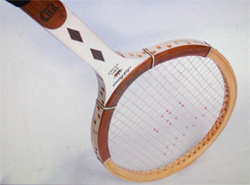
The first tournament I won, a city of Richmond California open tournament, I won at the age of 11 years, against an 18 year old named Brian Taylor. Brian thought he had won the match, but on match point I called his shot out.
He did not hear me, and he celebrated too early. I began to cry, and the tournament director asked Brian to play the point over. Technically it was my point. But it seemed fair to play the point over to me. You wouldn't see that kind of compromise today.
I ended up winning the match by coming back and grinding it out, much to Brian's dismay. But he was a good sport. The girls all loved him for his easy going nature, and curly hair.
To win that tournament I used a Value Village, 50 cent Bancroft fiber glass/steel reinforced frame, strung with piano wire, that was warped, even though I kept it pressed. The tournament prize was a Jack Kramer Autograph frame, diamond insert. The holy grail for a young player in that era.
That Jack Kramer stood for hope for me back in 1967. The diamond insert frame that I won stood for hope that someday I would become a great player.
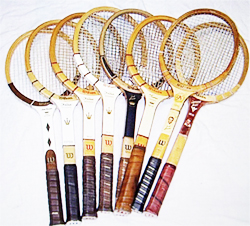
More important than love, or health, or joy, or most anything to tennis players is hope. Hope we can improve. Hope we can add a shot to our repertoire. Hope we can lose weight. Hope we can beat someone who has our number.
Hope that a new frame, a new string, a new technique is the answer. I still get excited when I string up a new hybrid I have not yet tried. I have hope that the latest experiment will be the holy grail of feel/power/touch.
The manufacturers know this. That is why they pay players to say they are using frames that the players are not really using, frames that are really no more than a paint job.
This is because confidence for tennis players is a very touchy thing. It takes years of practicing with the same frame, the same string, the same tension, to develop confidence.
That is why so many top pros use the same frames they did when they were juniors, no matter how far the technology has improved things. Look at Nadal or Murray.
Manufacturers bank on hope. They spread the paint jobs around.
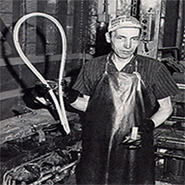
Even playing with that work of art, the Kramer, it still took me two more years before I ever beat my father, a hacker who sliced all his shots back short and with no pace.
A nightmare! A pusher father who gloated at my ineffective attempts to beat him. He even played out balls to give me a better chance of getting close, and to keep alive the hope that someday I would win.
That Kramer diamond insert I won was among the very last versions of the longest running athletic endorsement of all time. Kramer received endorsement money for 27 years, a feat unmatched by any other pro athlete in history!
Wilson made over 10 million Kramer frames, with many versions. They were hand made. There were 42 steps followed by a single craftsman. (Click Here to see all 42 of them described in the first person by the craftsman himself.)
Then compare that to fascinating video how Wilson designs and molds completely new prototypes in days. (Click Here) We all owe a debt of gratitude to racquet manufacturers, who often don't make much money, for their exacting work. It's their work which provides us hope.
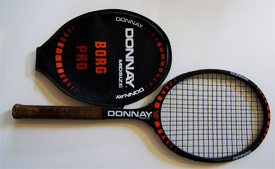
Many experts say that any frame from any era counts for about 70% of the playing feel/power/spin/touch/comfort. They say the string component makes up about 30%.
Exceptions occur with very good stringers, who are able to match the frame/string combination to fit the unique player's style and ability exactly. In these cases, the string can make up 50% of the equation. But many stringers can't even string wooden frames any more, as their machines won't allow it.
Those Kramer frames were made longer than any other frame in history. Any one lucky enough to hit and play with one felt the quality. These were wooden works of art.
When strung with victor imperial, the powerful blue spiral gut, they rivaled current frames for power and control, albeit with a smaller sweet spot, and a tighter string pattern, which favored flatter strokes over spin.
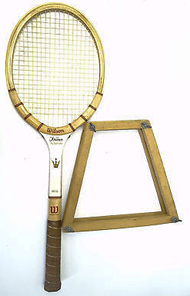
The stringing pattern was often 18 x 20, even in a 55- 65 sq. in. frame. The frame could weigh close to 400 grams, strung, gripped, and balanced. (Around 14.2 oz.) All top players used a full gut string job.
Many pro players of the wood racket era customized the frames to exact weights and balances. Borg: 410g, strung at 80lbs with full gut, by Lennart Bergelin, his coach, stringer, hitting partner, masseuse, and psychologist rolled into one.
The frames would warp if not pressed and warped anyway when exposed to humidity. They just don't make them like that anymore. The woodies bent, flexed, and vibrated at a much lower and more forgiving frequency than the modern frames do, so they were easier on the elbow.
There were many other manufacturers, such as Slazenger, Spalding, Donnay, Bancroft, Davis, etc., and hundreds of frames were available, just as they are today. No frame made today, matches the best of the woodies in control and feel, due to the tighter string patterns, flexier lay ups, and natural gut string.
But for the modern game those frames would be too heavy, their sweet spots too small. The tight string patterns could never produce enough spin, and the wooden frames would break.
For all of us who started with woodies, and remember that first feeling of hope, we are brothers of a small community. A player is nothing without hope and faith.
My motto in those days was fight with your mind first and your Jack Kramer autograph second. Today I keep that spark alive that flamed up so long ago by trying out new frames, new string, and new stringing hybrids. Just another son taught by a hacker father with a woodie.




